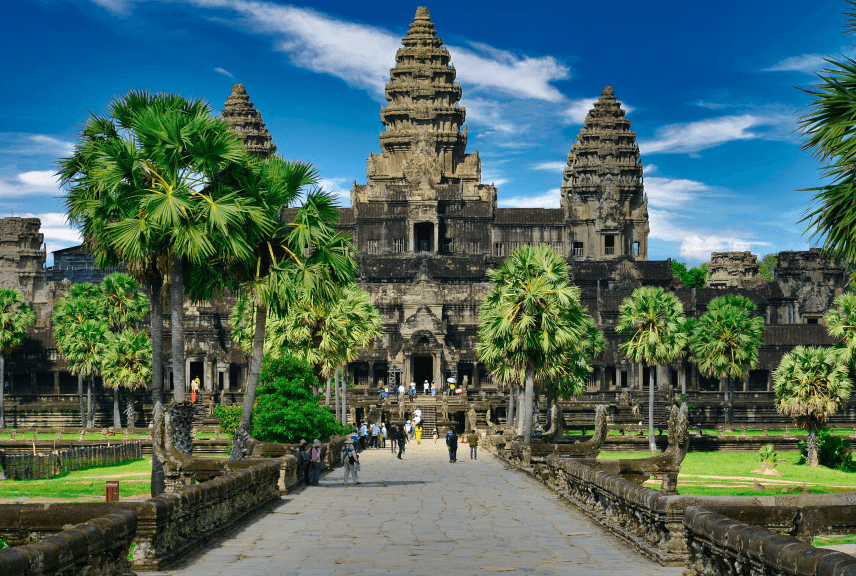Historical sites included museums, architecture, forests, mountainsm waterfalls, birds singing and traditional customs and culture
The temple is one of the most attractive to examine about Lao culture. Those who don’t understand about religious say that the temple is the place for offerings and place for lazy people.
In fact, the temple is very important for Lao people and their daily lives. This land was formerly called Souvannaphoum, or Lanexang kingdom, but today it is called Lao PDR. In the early times, Lao people believed in ghosts like Phifa, the sky, Phithene, the god, Phitack, the rice field ghost.
Laos was buddhist when Kunluanglimao was governor of Ai-Lao in 68 AD. (Buddhist calendar in the years of 612). But after the Lao moved to Lanexang territory, they believe in the ghosts. When king Fang united the nation and Nang Keokenggna, his wife requested that he bring king Buddhiwm of Langkavog or Hinagnane from Cambodia.
In 1329 (Buddhist calendar 1902) Phra Maha Pasaman, the old mank and Phra Maha Theplangka followed by 20 monk and 3 wise men brought in Buddhism from Cambodia. They brought in the Buddha image made by five different metals called Phrabang.
Following Phra Maha Pasaman were a number of technicians such as : black smiths, copper smiths and gold smiths who make the Buddha image and music band of the total 5,000 persons. Since that event, many temples have been built for monks, novices and their followers to conduct Buddhist teacher teachings and organise Buddhist ceremonies.
– Library, place to study, research, teaching books and other documents.
– Museum and places to produce arts.
– Meeting places for all generations.
– Use as visiting rooms or guest house including the poor and the orphanage.
– Public places.
The above roles and actives are performed in the temples so no one can look down or break the rules of the temples and all people recognise that temples are the respected and magical centers. To enter to the temple people should pay respects from their bodies, words and hearts. Entering into the temple yard, it is cleaner and more beautiful than other places. The temple is more beautiful than houses because the villagers offers their best things to the temple properties. therefore, temples are the great heritage for the whole sociaty and the nation.
In the past, the temple was the center place for donations and the production center for Lao culture. To establish the village, people like to build the temple as well. Some villages have more than one temple. As we have seen, there are many pagodas and temples in Luangphrabang and Vientiane, because these two cities are the capitals of the nation. According to the history before the Siamese invasion, Vientiane had more than 120 temples.
The famous temples in Luangphrabang are : Wat Manolom built by Choa Samsenethai, son of FaNgum King in the 14th century (1378-79), Wat Visoune built by Chao Vixounenalath 1540, Wat Xiangthong built by Sayset Thathirath in 1560, Wat Sene Soukalam by Kingkitsalath in 1718, Wat Luang by Manthatoulath in 1818 and Wat Mai built by Chao Souvannaphoummaram in the 15-16 century.
In Vientiane : Wat Phrakeo built in 1565, Wat Sisaket 1824 by Anouvong, Wat Ong Tue in the 15th century, Wat Inpeng in 16th century, Wat Thatluang, Wat Sokphaluang, Wat Simoung ….
At Savannakhet : Wat Xiagnaphoum, Wat Xaignamonkhoune …
At Pakse : Wat Pho, Wat prabath, Wat Phou Champasak ….
These temples above are mainly in the big cities and along the Mekong. Others in the mountainous and remote provinces like Houaphan, Xiangkhoang, Salavan, Attapue were almost destroyed by the war. The temple or Wat is the place to organise the Buddhist ceremonies and rites such as : Bun, Buddhist ceremonies which is once performed in every 12 month. No one can separate the temple and the ceremonies.
WAT PHU
The Ancient City, The Sanctuary, The Spring
The religious complex of Wat Phu is of Khmer architecture and Hindu religious and is situated at the foot of a hill. The summit, the Phu Kao, immediately commands one attention because of its shape, identified in the ancient time with the linga, the phallic symbol of Shiva, from which originated its ancient name, Lingaparvata, and its reputation aas a sacred hill. The permanent spring, at the foot of the cliffs, is probably one of the main reasons that induced the ancient rulers of the area to establish a Shivaist sanctuary there. Associated with this religious complex, inthe pain below, on the bank of the Mekong, is a pre-Angkorian city, the remains of which ( large earthen enclosure walls, brick monuments ) are barely visible on the ground, although they appear quite clearly on aerial pictures. Since 1991, excavation have been undertaken by P.R A.L. (Project de Recherches en Archeologie Lao) with the aim of producing a precise archaeological map.
WAT PHABAT PHONESANE
Wat Phabat Phonesane is one of the most important temples and tourist sites in Bolikh- amxai province. It is situated km 82 from Vientiane on the left hand side of road N.13 south. Wat Naganimid Phonesane was first built on the right hand side and 2 km from the natio- nal road to the Mekong river.
Wat Phabat Phonesane is the Lord of Buddha foot print teple and stupa. It is beautiful place to visit and worship. Wat Naganimid was built of the top pf the hill and has 100 stairs and surrounded by the big trees which made the temple more attractive. Wat Phabat Phonesane and Wat Naganimid are not the same temples.
There is an old saying which say that Wat Phabat Phonesane place the Lord Buddha sit for lunch, when he srrived from Somphoutavib to teach the Buddha’s word. When he looked for a place to sit for lunch, there were no places for him, becuase everywhere were his former graveyards. Because of that, the king of the dragon named Soukahathinak collested the rocks and soils to form the hill for him to have lunch. After lunch, before he said good bye, the dragons named Soukahathinak and Sangkala- nak requested him to print this foot print as the symbol of Buddhism in Kokchikviengngoua hill which was as far as the shout of an elephant from the place where he took lunch. The Lord Buddha printed his foot print on the rock as we have seen in Wat Phabat Phonesane.
The size of the foot print is 40 cm deep 1.20 cm wide and length 2.40 cm. the nails of the foot are the same length. The images of the wheel, the lotus and one hundred and eight types of animals marked in the central of the foot. It was his right leg and facing to the Mekong river. After the image of the Buddha foot was printed, the dragon arranged a religious ceremony then returned to their kingdom. Since than, at the end of the Buddhist lent, the king of the Naga and his followers have organized rocket festivals to worship the print in an annual ceremony. That is because people see the man made rockets lights launched from the land and the river. It is called Bangfai PhaNhanak (The Naga rocket).
WAT SISAKET
Any local and foreign tourists who visit Vientiane to see pagodas or old historical sites, should also include a short visit to Wat Sisaket. Here tou will see the bid Buddha image, libraly and wall paintings. If you do not visit Wat Sisaket you will not have seen the heart of Vientiane. When you return home, you will dream of Vientiane.
OLD WAT SISAKET:
This temple was built in 1818 by King Anouvong, the last king of the Vientiane monarchy. Its first name called was Satassahatsaram which means Watsene, but it is now know as Wat Sisaket. It is located in the former yard of the king’s palace, inside the first Vientiane fence. Now it is at front of the Presidential Palace.
It was very important at the beginning of the 19th century when only one pagada remained after Vientiane was burnt down in 1829. Some of the Buddha images and artifacts remain including a big Buddha image, two copper buddha images and 120 lime Buddha images reflecting the designs of the 19th century to the present time.
Wat Sisaket was sponsored by a king. It houses artifacts made of gold, silver and many types of sapphire. It is a national heritage. Unfortunately, though a large number os things have gone and only a few of them remain.
RESTORATION OF WAT SISAKET:
It was first restored in 1924. Then in 1930 large scale renovations were made includeing the library. Restoration costs were financed by local people and the Goverment. French experts contributed technical assistance.
IMPORTANT HISTORICAL SITE:
Wat Sisaket has housed the cultural heritage since 1924. The arts and Buddha images were designed in the 15-19 centuries. Old Hotel library wall was covered with sapphires. The milestone placed at the wall of the right hand side in the west of the fence shows that this pagada was built in 1818. This milestone is worth of history because it shows the letters and literature at the beginning of the 19th century.
The big Buddha image made of bricks and two other copper Buddha images manifest the finest design showing the high skill of the artists of the 19th century. The candle stand is 1.88 meter high and 2.10 meter wide. It is made if hard wood specially designed in 19th century.
The walls are painted in different colors. The walls portray a flok story called PhraNha Bakkalaphat in the paintings, the Siamese arets and costume can be observed, for example man wearing a hat of the western style. This type of painting can also be seen in Luangphrabang at Wat Pakkae and the book boards in Luangphrabang palace. All are designed in the 18th and 19th certuries.
120 lime Buddha images placed at the 4 corners are the finest styles of arts made in the 19th century. The big Buddha images which has as its registered number 93, is a height of 1.02 meters. This was made in the 15th century (in 1490) and is in the same style as other work designed by Manolom Luangphrabane technician. Only a few temples of this style can be seen in Vientiane.
The door frame at the back of the temple is made of lime and is 2.55 meters high, and 1.27 meters wide. The above shown the brief history of Wat Sisaket or Watsatasahatsaram. In the past it was built in a big yard surrounding the area of Hotai library which includes the inside pagoda territory. Since Lanexang Avenue was reconstructed and the surface of road was widened in 1960s, the Hotai library has stood outside the pagada wall.







